- Comics
- Comics Reviews
- Manga
- Comics Reviews
- European Comics
- News
- Comics News
- Press Releases
- Columns
- Spotlight
- Digital Comics
- Webcomics
- Cult Favorite
- Back Issues
- Webcomics
- Movies
- Toys
- Store
- More
- About
By Andy Frisk
October 16, 2010 - 21:30
When Owen, a 12 year old bullied and beaten boy, asks his father if evil is real and his father retorts with an attack against his mother for “putting that crap” in his head (Owen’s parents are estranged), he essentially answers Owen’s question. Not only is there evil in the world, evil is multifaceted. Self-centeredness, selfishness, envy, bigotry, violence, and manipulation are all facets of evil, and they do, very assuredly, exist. All are on display in Let Me In, the American remake of the Swedish film and novel Let The Right One In. Let Me In is the story of Owen, the bullied and beaten boy who’s living, not only through the torturous life of a bullying victim, but the separation of his parents, and Abby, a perpetually 12 year old girl who must consume blood to survive and must be invited into your home to enter unharmed. Yes, Abby is a vampire.
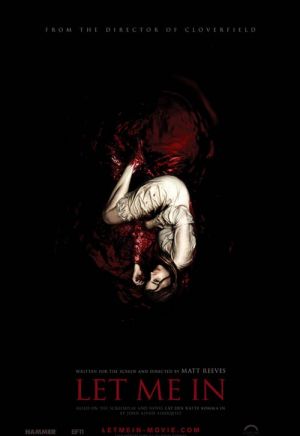 |
At first, not knowing about the original version of the film and its source novel, I was inclined to overlook this film as another inane attempt to capitalize on the vampire craze. The film stars the equally brilliant Chloe Moretz (Kick-Ass) and Kodi Smit-McPhee (The Road), so assured of at least some superb acting, I checked the film out. It was well worth the time.
To begin with, this look at Let Me In will contain some spoilers, so if you’d rather see the film first and come back with your own conclusions to weigh against those presented herein, then you’ll probably get more out of this examination (as opposed to straightforward review) of Let Me In, its predecessor, and source novel. One really cannot, with any serious depth, consider the many themes and questions this film raises about human nature and the nature of evil without discussing not only plot details, but the previous version of the film and the novel. Again though, like the time I spent watching the film, such a consideration of the themes of Let Me In is well worth it.
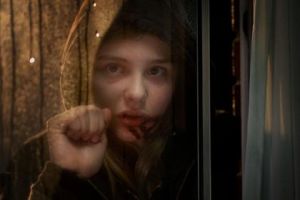 |
“Is there such a thing as evil?” Owen asks his estranged father on the phone shortly after learning that his best and only friend Abby is a vampire. Owen, a severely bullied boy, has no friends and no parents—emotionally. The bullies who torment him call him “little girl” and continually harass him viciously. Owen dreams of fighting back, repeatedly stabbing his pocket knife into a tree in the courtyard/playground of his apartment complex while muttering, “How do you like that little girl?” That’s when and where he meets Abby; the strange girl who just moved in next door who has a penchant for walking in the snow barefoot and is constantly way underdressed for the time of year. She also keeps her windows covered with cardboard, doesn’t go to school, and is never around during the day. When Owen attempts to befriend her, she immediately responds with “We can’t be friends.” They are kindred souls who share a marginalized and outcast existence though, or so it appears, and a friendship and innocent adolescent romance blossoms, but Abby is a vampire, and when the man Owen assumes is her father, but is really her caretaker, a man who stalks human prey to provide her with the sustenance she need, is no longer able to fulfill his duties and ends up sacrificing himself to her, out of love, Abby is forced to acquire her prey herself. When Owen witnesses Abby kill an innocent police detective, her and Owen’s friendship is seriously tested. Abby just might have found a new caretaker though as Owen has fallen in love with her, especially after Abby ends up saving his life, in more ways than one...
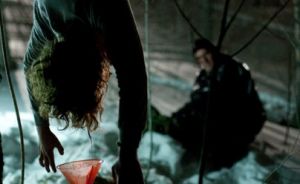 |
So, is there such a thing as evil? The bullying done by Owen’s older schoolmates is obviously evil in nature. The hinted at infidelity that broke up Owen’s parents can be considered evil in nature due to the emotional results it wrought upon Owen’s mother and, by extension, Owen himself. The cold blooded murders that Abby’s caretaker commits in order to feed her are considerably evil in nature. All of these acts are selfish in nature. The perpetrators of these acts all are receiving some sort of personal benefit or fulfillment out of committing them. Abby’s actions are of a slightly different nature though. She must kill and consume blood to survive. One cannot consider the act of a lion killing a gazelle evil as the lion is biologically compelled to do so in order to survive. The lion doesn’t kill for sport, it kills to survive. Thus is the cycle of nature. So perhaps Abby isn’t evil. Owen must come to this conclusion at some point, but can Abby be accurately compared to a lion? A human being, even one afflicted with a fictional vampiric curse, is consciously, intellectually, and, some would say, even spiritually on a much higher plane than a lion…
 |
This quandary leads to the most important question the film raises. Say Abby can’t control herself and is forced to kill spontaneously at the site of blood or when she is threatened and she needs blood to survive, so she isn’t evil through and through because killing and consuming blood is in her biological nature. What about her relationship with her caretaker? Her caretaker stalks and kills innocent victims in order to keep Abby alive and her strange qualities (super strength, deadly aversion to sunlight, and method of killing) hidden. The people that her caretaker kills can be chalked up to serial killings, crimes of passion, etc. and keep Abby’s vampirism hidden and therefore less attractive to the launching of a witch hunt in order to find her, or others like her, once word gets out that her kind do exist. Abby also needs the cover of a father figure or adult to complete the disguise and societal show she has to put on to maintain a relatively normal existence. Now that her caretaker is getting older though, and isn’t as competent at providing Abby with what she needs, is she simply staking out her next caretaker in Owen? Yes, there is an attraction between the two. That’s obvious, but again, if Abby has “been 12 for a very long time” one must assume for more than at least twice the average lifetime, wouldn’t she be very knowledgeable in the ways of maintaining her existence, especially the need to attract and manipulate a future caretaker into falling in love with her? More importantly, wouldn’t she be pretty good at staking out the type of personality that would obviously fall in love with and end up fulfilling the role she needs? Is she simply a manipulative vampire in the metaphorically emotional and literal sense of the word by sucking Owen into a relationship with her? In turn then, is love itself a vampiric type of relationship where two individuals feed off of one another in order to fulfill some personal need? If so, Abby's manipulation of Owen's awkward stirrings of first time love can be seen as quite the evil act as it robs Owen of his life just as if she slew him with her teeth.
Certainly, as Let Me In suggests, this very well might be the case. In the film, Abby’s current adult caretaker is revealed to have known Abby from the time he was Owen’s age. In Let The Right One In, and more specifically in the source novel, her current caretaker is suggested to be a pedophile whom Abby meets when he is in his 40’s. Their relationship is much darker, symbiotic, tragic, and disgusting in nature. Abby’s (Eli in the Swedish film and novel) motivations for moving on to form a relationship with Owen’s character (named Oskar in the Swedish film and novel) are much more understandable under these circumstances.
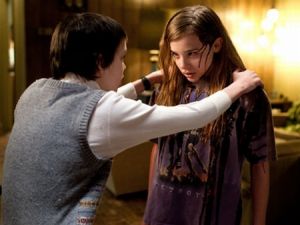 |
This change in Abby’s caretaker’s history and motivation make the Abby of Let Me In as opposed to the Eli of Let The Right One In much more manipulative and evil in nature. Owen is metaphorically as much a victim of Abby's vampiric nature as her physical victims are. It seems that director/screenwriter Matt Reeves (Cloverfield) decided to present a decidedly less ambiguous characterization of Abby than Swedish director Tomas Alfredson and novelist John Ajvide Lindqvist did of Eli. This isn’t the only change that Reeves makes. In Let The Right One In, Eli is an emasculated boy who was castrated and turned into a vampire in order to forcibly serve in some sort of sick vampire ritual. Oskar doesn’t even become intimately aware of this fact until he is already deeply in love with Eli, and by that point Eli’s ambiguous sexuality is almost a moot point. This plot element gives birth to a whole other line of thematic and metaphoric inquiry that we’ll not delve into here since Let Me In seems to hint at this plot element, but glosses it over and really almost makes it irrelevant in Reeves’ version of the film. It is another element to the literary quality of Let Me In/Let the Right One In (the films and the novel) though that does deserve paying attention to and addressing. Reeves also leaves out the darker side of Oskar’s character in his characterization of Owen. Oskar collects not only knives, but newspaper clippings of grotesque murders and accidents. One important aspect that Reeves does keep from Let The Right One In (film and novel) is the early 1980s setting. In Sweden, during one of the high points of the Cold War, the specter of nuclear annihilation was very real given the close proximity of Sweden to the Soviet Union, and the harsh rhetoric of the early Reagan/Gorbechev years. For anyone who was anywhere near the age of Owen/Oskar during this time period, the very palpable fear in the air over nuclear war and its resulting horrors was very real, and very frightening. There are also thematic elements that can be pursued and dissected with relation to the films’ and novel’s time period setting, such as the burgeoning electronic and information age that will soon burst onto the scene, making it harder for someone like Abby/Eli to remain as carefully hidden. One gets the feeling that Let Me In and Let The Right One In are ample candidates for a post-modern literature class. It would have fit well into the Post Modern (Post 1980) Literature class I took as an undergraduate back in college…
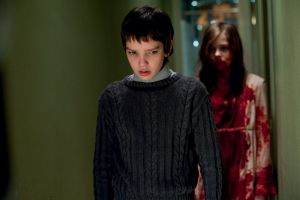 |
This unique take on the vampire tale and myth is interesting in its use of vampirism as a metaphor to shock the reader into considering some very real and non fanciful themes, the most powerful of which, obviously, is the nature of evil. Abby’s apparent evilness in Let Me In makes for a rather depressing tale overall. It seems that evil does truly exist, and that the innocent Owen, who is alone, alienated, and desirous of a need to belong and to be loved is a most heart wrenching victim. Reeves’ decision to thematically vilify Abby, and by extension their relationship, and possibly even the nature of love, beyond a point of almost no alternative consideration really makes for a near nihilistic view of the world and all those in it. (The assertion that Abby is purely evil is still debatable mind you—simply peruse the message boards of IMDB.com—if you can stomach the immaturity that abounds there—and you’ll see many lively debates taking place over the nature of Abby as a villain or victim.)
As a visual piece of art, Let Me In is masterfully filmed and acted. The slow, at time torturously slow, unfolding of certain scenes, including Abby’s first vampiric episode in front of Owen, and the horrific scene where Abby nearly bleeds out and dies as a consequence of entering Owen’s home uninvited are as frightening as they are visually striking. The entire film unfolds slowly with camera movement that perfectly frames and enhances Chloe Moretz and Kodi Smit-McPhee’s subtly nuanced performances. Their slowly unfolding conversations, that through short sentences convey much more meaning than the few words that compose them are intended to, are framed by their facial expressions and slight changes in tone, eyebrow movement, and widening or closing of their eyes. These two kids are already displaying an incredibly accomplished grasp of one of the hardest aspects of acting: subtlety—in tone of voice, look of eye, and nod of head. The sky is the limit for these two.
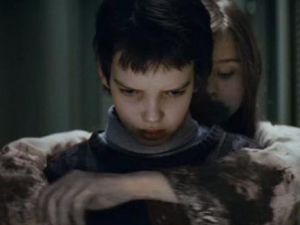 |
Rarely does a film and novel come along that so powerfully makes use of a very trite and overexposed pop culture fad like vampirism and actually bring gothic horror, as a genre, back to its roots. Let Me In and Let The Right One In are films and novels that in the categories of depth, breadth, and literary merit stand should to shoulder with the greats of literary gothic horror like Mary Shelley’s Frankenstein and Oscar Wilde’s Picture of Dorian Gray. Both these works used horror and the supernatural as metaphor for very real human questions quite masterfully. So do the trinity of Let Me In films and novel just as masterfully.
Rating: 10 /10